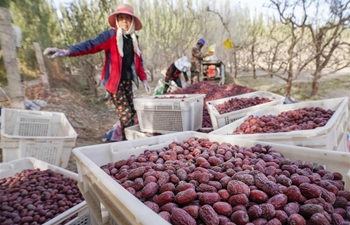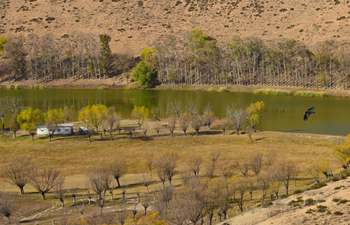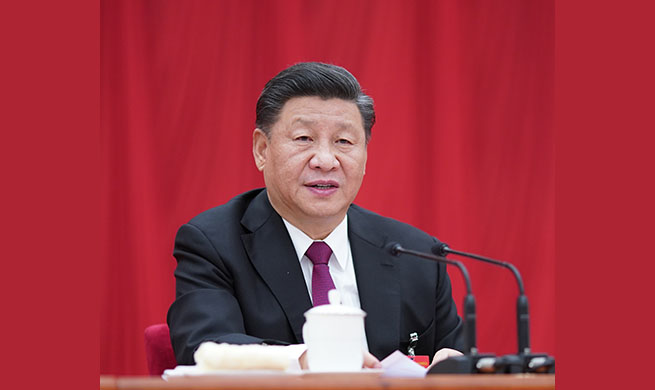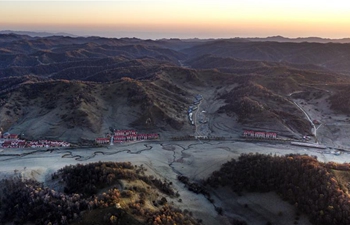LANZHOU, Nov. 1 (Xinhua) -- Fan Lide, 42, used to be a taxi driver. He is now the owner of 36 greenhouses producing organic vegetables in the barren Gobi desert in northwest China's Gansu Province, and his business has been expanding over the past 10 years.
"Being a taxi driver, you have to work long hours every day. In the end, you have to pay a bulk of the revenue for renting the car. Now I'm even busier, but I work for myself and am much better off," Fan said.
Fan is one of the beneficiaries of the Gobi Farming Program of the Gansu Province that is building rows of greenhouses in the desert to help transform local farming and alleviate poverty.
Grain production in Gansu, which has more than 6.7 million hectares of Gobi desert and 12 million hectares of sandy land, is greatly affected by the climate and the output is unstable.
Agricultural production there relies heavily on rivers, oases and groundwater irrigation. If traditional extensive agricultural production continued, it could gradually narrow the living space.
In 1995, Song Younian, an entrepreneur of the city of Zhangye in central Gansu, ventured to use Israeli technologies to build greenhouses for vegetables growing in the desert.
Such individual pilot projects encouraged the Gansu government to launch a provincial-level Gobi farming program in 2017 with a target to build up a controlled-environment agriculture of about 20,000 hectares by 2022. Some cities in the province, such as Zhangye and Jiuquan, where Fan's village is located, have already been experimenting with Gobi farming for several years.
Despite the harsh environment, farming in the Gobi desert has its advantages: The extended amount of sunlight provides adequate energy for crops, a significant temperature difference between day and night helps crops accumulate nutrients and the Gobi's hot and dry air means fewer pests and crop diseases.
The Gobi greenhouses popping up in Gansu use drip and spray irrigation, which can cut water consumption by almost 50 percent compared to a normal farm, according to Yan Shengjun, an agricultural adviser who serves as a consultant for local farmers such as Fan.
The greenhouses are also eco-friendly, as they use substrates for soilless cultivation recycled from rotten leaves, straw and cow and sheep feces.
"Each hectare of the greenhouses can recycle around 600 cubic meters of agricultural waste," Yan said, "The waste serves as organic fertilizer, helping improve the quality of the vegetables."
With the greenhouses, Fan earns around 70,000 yuan (9,950 U.S. dollars) annually.
"Vegetables produced in the greenhouses are harvested twice or three times a year. As organic food gets more popular in the market, our income also increases," Fan said.
Data from Suzhou District of Jiuquan showed the greenhouse program has helped bring an average revenue of about 72,300 U.S. dollars per hectare to local farmers.
Large-scale greenhouse farming is an investment-intensive project and cannot be sustained only by government financial support. Therefore, the local government has been encouraging villagers such as Fan to take the lead to rent greenhouses or build their own, supported by financing packages provided by financial institutions.
It is not an easy task, and many villagers still want to wait and see. However, more and more are starting to join in, either to run their own greenhouses or work as hired workers for greenhouse owners.
Starting from managing four greenhouses in 2009, Fan now is also a partner of a greenhouse farming cooperative running 120 greenhouses.
The relative low cost of large-scale land use in the Gobi desert, as well as government financial support, have also encouraged large firms to start their Gobi farming pilot projects in Gansu, forming a promising partnership of government, enterprises, cooperatives and local villagers.
Local officials said if the Gobi farming proves successful, it could provide experiences for countries in Central Asia linked with Gansu both by the Ancient Silk Road as well as its modern version of the Belt and Road Initiative.

















